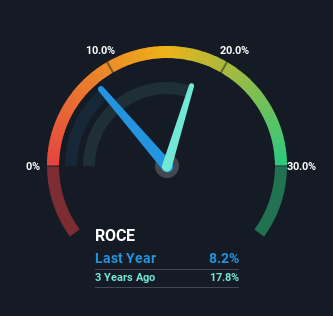- United States
- /
- Machinery
- /
- NasdaqGS:ERII
Returns At Energy Recovery (NASDAQ:ERII) Appear To Be Weighed Down

If you're looking for a multi-bagger, there's a few things to keep an eye out for. Firstly, we'll want to see a proven return on capital employed (ROCE) that is increasing, and secondly, an expanding base of capital employed. Basically this means that a company has profitable initiatives that it can continue to reinvest in, which is a trait of a compounding machine. Having said that, from a first glance at Energy Recovery (NASDAQ:ERII) we aren't jumping out of our chairs at how returns are trending, but let's have a deeper look.
Return On Capital Employed (ROCE): What Is It?
Just to clarify if you're unsure, ROCE is a metric for evaluating how much pre-tax income (in percentage terms) a company earns on the capital invested in its business. To calculate this metric for Energy Recovery, this is the formula:
Return on Capital Employed = Earnings Before Interest and Tax (EBIT) ÷ (Total Assets - Current Liabilities)
0.082 = US$19m ÷ (US$253m - US$21m) (Based on the trailing twelve months to December 2023).
Therefore, Energy Recovery has an ROCE of 8.2%. In absolute terms, that's a low return and it also under-performs the Machinery industry average of 13%.
See our latest analysis for Energy Recovery

Above you can see how the current ROCE for Energy Recovery compares to its prior returns on capital, but there's only so much you can tell from the past. If you're interested, you can view the analysts predictions in our free analyst report for Energy Recovery .
What Can We Tell From Energy Recovery's ROCE Trend?
In terms of Energy Recovery's historical ROCE trend, it doesn't exactly demand attention. The company has consistently earned 8.2% for the last five years, and the capital employed within the business has risen 52% in that time. This poor ROCE doesn't inspire confidence right now, and with the increase in capital employed, it's evident that the business isn't deploying the funds into high return investments.
The Key Takeaway
In conclusion, Energy Recovery has been investing more capital into the business, but returns on that capital haven't increased. Since the stock has gained an impressive 80% over the last five years, investors must think there's better things to come. Ultimately, if the underlying trends persist, we wouldn't hold our breath on it being a multi-bagger going forward.
If you want to continue researching Energy Recovery, you might be interested to know about the 1 warning sign that our analysis has discovered.
While Energy Recovery may not currently earn the highest returns, we've compiled a list of companies that currently earn more than 25% return on equity. Check out this free list here.
Valuation is complex, but we're here to simplify it.
Discover if Energy Recovery might be undervalued or overvalued with our detailed analysis, featuring fair value estimates, potential risks, dividends, insider trades, and its financial condition.
Access Free AnalysisHave feedback on this article? Concerned about the content? Get in touch with us directly. Alternatively, email editorial-team (at) simplywallst.com.
This article by Simply Wall St is general in nature. We provide commentary based on historical data and analyst forecasts only using an unbiased methodology and our articles are not intended to be financial advice. It does not constitute a recommendation to buy or sell any stock, and does not take account of your objectives, or your financial situation. We aim to bring you long-term focused analysis driven by fundamental data. Note that our analysis may not factor in the latest price-sensitive company announcements or qualitative material. Simply Wall St has no position in any stocks mentioned.
About NasdaqGS:ERII
Energy Recovery
Designs, manufactures, and sells energy efficiency technology solutions in the United States, North, South and Latin America, the Middle East, Northern Africa, Asia, and Europe.
Flawless balance sheet with reasonable growth potential.
Similar Companies
Market Insights
Community Narratives




